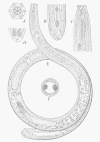 . .
|
- Body about cylindrical from the middle of the neck to a short
distance in front of the anus.
- Lateral organs number from 45-55 on each side of the body,
irregular in size and arrangement, each with a connection extends
through the cuticle to a pore.
- Lip region 1/2 as wide as base of neck, set off by a
constriction, bearing an inner circlet of six and an outer circlet
of ten papillae.
- Amphids stirrup shaped, almost 1/3 as wide as lip region.
- Spear about 2/3 as long as lip region width, the aperture
occupying 1/2 its length
- Guiding ring a muscular sheath.
- Esophagus irregular in width anteriorly, with strong
radial musculature, narrowing as it passes through the nerve ring,
then abruptly expanded in the posterior 3/5.
- Five esophageal glands.
- Base of esophagus surrounded by a membrane-like sheath.
- Cardia pineapple shaped.
- Each cell of the thick walled intestine with a group of large
granules.
- Prerectum length equal to three times the anal body diameter.
Rectum length equal to anal body diameter.
- Tail hemispheroid.
Female
- Vulva a transverse slit.
- Vagina refractive, extending more than 1/3 across the body.
- Didelphic, amphidelphic. Ovaries symmetrical, reflexed 1/2 the
way back to the vulva when not displaced by developing ova.
Ref: Fielding, 1950
|